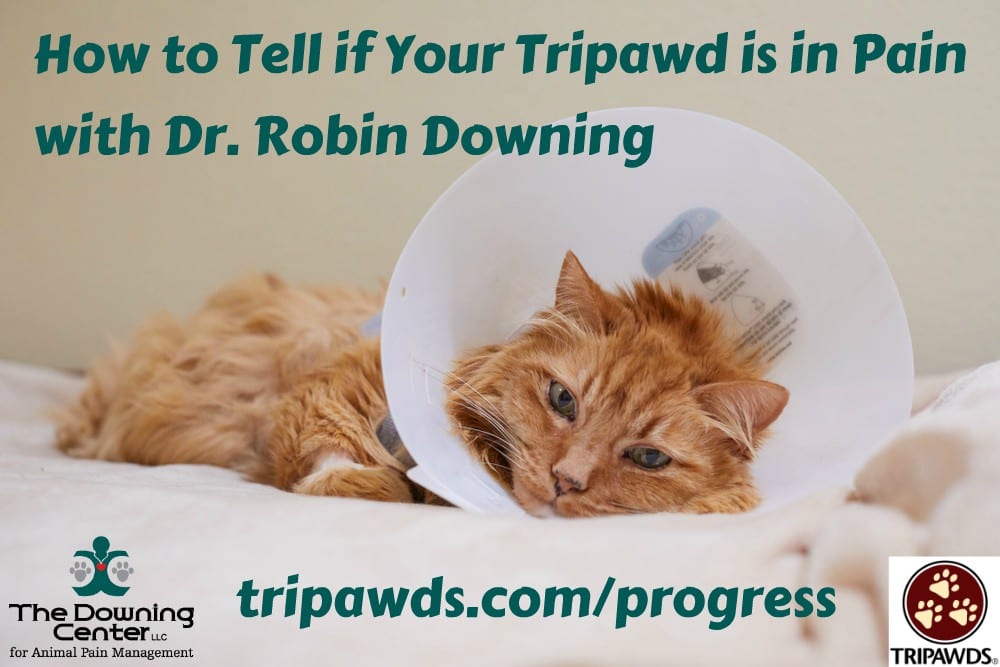Amputation recovery is a constant guessing game of asking yourself: “Is my new Tripawd in pain?” Today you’ll learn how tell, with world-renowned animal pain management expert Dr. Robin Downing.

How to Read Your Tripawd’s Pain Signals
A Tripawd in pain communicates non-verbal clues. Your job is to read them. In the second video with Dr. Downing, she explains how. Watching for the return of your pet’s normal behaviors is one way. For example, when cats start grooming again or when dogs excited about favorite activities, you know a Tripawd has less pain.
Dr. Downing also explains how to manage acute pain, inflammation and swelling after amputation surgery. Watch and learn.
Over the next month, watch for all seven videos with Dr. Downing:
Video 1: Why we must advocate for our Tripawds
Video 2: How to know if your pet is in pain
Video 3: The truth about phantom leg pain in Tripawds
Video 4: How to Manage Amputation Recovery Pain in Pets
Video 5: Help manage Tripawd phantom pain with Gabapentin
Video 6: Pet pain quality of life tips
Video 7: How to help a Tripawd age well
Video Transcript:
Is Your Tripawd In Pain?
Tripawds: What is the difference between pain signals versus medication side effects? How are we as pet parents supposed to decipher that?
Dr. Downing: So deciphering the difference between pain signals or the animal showing us pain and medication side effects, sometimes those will overlap. But for the most part, how I educate my clients is to watch for the restoration of normal behaviors.
No one knows your pets’ normal behaviors better than you do. So we’re looking for a restoration of grooming behaviors in cats. For instance, we’re looking for cats that aren’t interested in being under the bed. They want to be where they normally would be.
We’re looking for dogs to ask for meals at mealtimes. We’re asking for dogs – we want to watch for dogs to ask for, “This is when I go outside to go to the bathroom.” Oh, I see you picked up the leash. Now I’m excited. Even if they are a little bit impaired because of having a recent amputation.
What else can we do to help?
The other piece that we need to be thinking about as pet owners whose animals experienced an amputation are some of the physical medicine things we can do at home that will not only help us better manage their pain overall, but will also enhance our relationship with them. But I think it also puts us in the path of understanding if they’re having a problem.
So for instance, if I send a patient home who has had an amputation, one of the things I’m going to guide my clients to do is some icing of that area immediately post-operatively because we know that cold therapy decreases inflammation and pain.
I’m going to have them do a little bit of medical massage. Then I will teach them. That will help the tissues not become swollen or resolve any swelling that happens. If the dog or the cat objects to that, that’s a signal – that’s a pain signal. That’s not a, “I’m having a side effect from a medication.”
Another tool that we can use at home that is a high-tech but high safety and we can use it in any setting is the Assisi Loop, which uses targeted electromagnetic pulse therapy. We know from clinical studies in humans and now we actually have a published study in dogs. That this is a very effective way for us to manage acute pain, inflammation and swelling post-operatively.
Well, if you’re not meeting our standard, that animal is not going to lay still for a therapy like that and that’s how we can distinguish between an animal that’s trying to tell us, “I’m still painful,” versus an animal who is not wanting to move because they’re having an adverse reaction to a medication.
[End of transcript]
We are 9 days post-surgery. My annie is a Malinois. Pre surgery she had very high energy and high prey drive. She is on tramadol and seems to be doing okay with the pain as far as I know but has absolutely no energy. Difficult to get her up to go to the bathroom. Is not interested much an eating. And does not lift her head when we come into the room or wag her tail much. Not sure if that is too much to expect so soon. Either way this is extremely difficult to watch and I continue to second-guess myself with did I do the right thing? Please share any advice you may have and if this is normal? I know she is only 9 days post-op but her chemo is set to start next week and I’m concerned about putting her through even more trauma. She had cancer in her front left leg. Her incision looks great and is healing well. Any advice is appreciated.
Most members see vast improvement in their pups once off the pain meds. Annie may surprise you before you know it…until then, confinement and moderated activity are a must for a speedy recovery! Consult your vet with serious concerns, and check out the many Tripawds News posts about what to expect during these early days. Post in the forums for much more feedback from others!